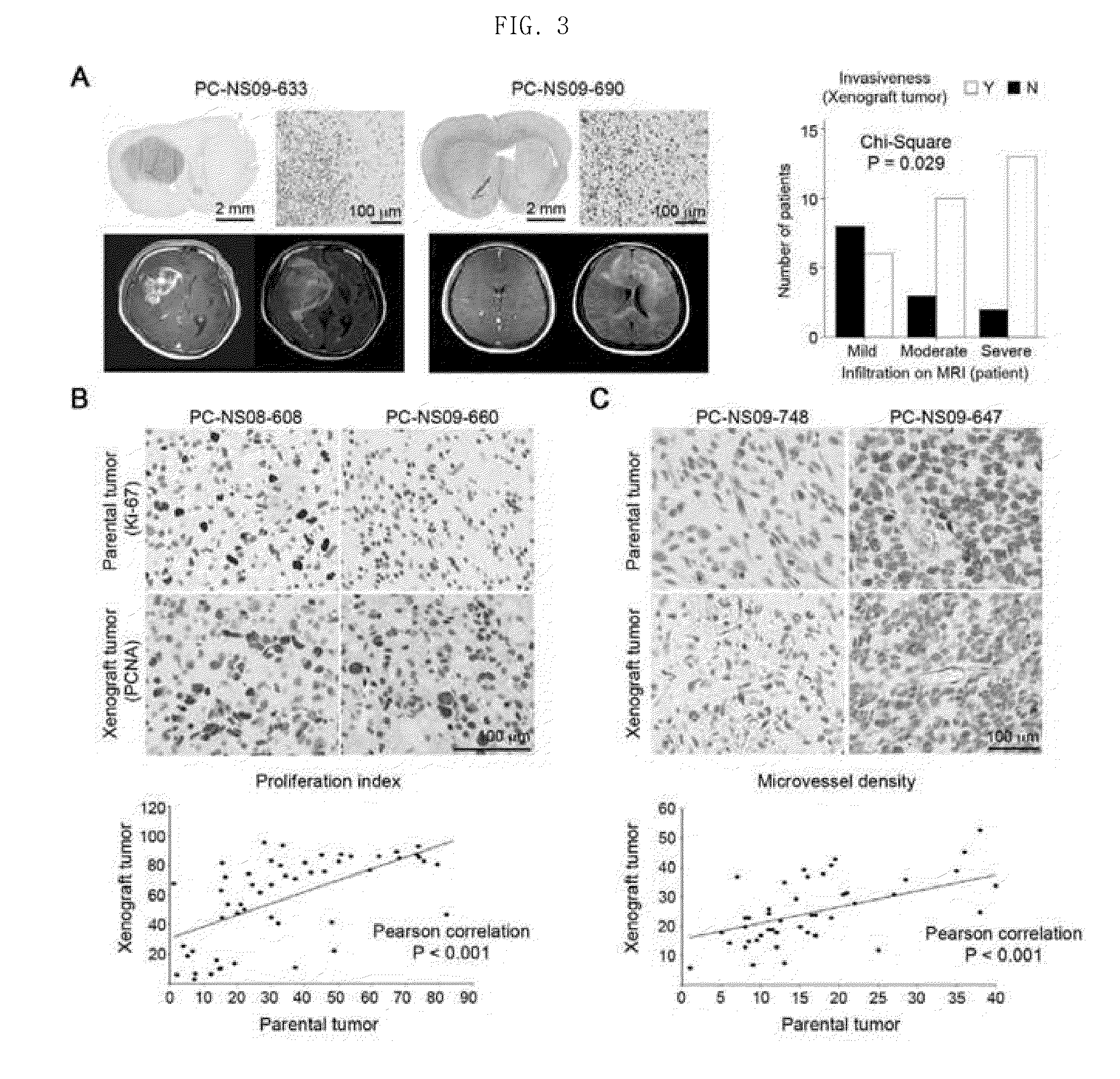Method for preparing patient-specific glioblastoma animal model, and uses thereof
a glioblastoma and mouse model technology, applied in the field of preparing patient-specific glioblastoma animal models, can solve the problems of difficult treatment, high incidence, and unreported effective treatment methods other than radiotherapy for gliomas, and achieve safe and effective patient-specific glioblastoma
- Summary
- Abstract
- Description
- Claims
- Application Information
AI Technical Summary
Benefits of technology
Problems solved by technology
Method used
Image
Examples
example 1
Glioblastoma (GBM) Patients and the Primary Culture of Cell Cultures Derived from the Patients
[0059]Following informed consent, surgical samples and clinical records were obtained from 58 GBM patients who had brain tumor removal surgery at the Samsung Medical Center (Seoul, Korea), and data thereon are shown in FIG. 1. Specifically, FIG. 1 shows the clinical data of glioblastoma patients and experimental results for primarily cultured glioblastoma (GBM) cells derived from the patients.
[0060]The obtained surgical samples were classified as GBM based on WHO criteria by examination of pathologists. Parts of the surgical samples were enzymatically dissociated into single cells, and the dissociated GBM cells were cultured in the “NBE” condition. Specifically, the dissociated GBM cells were cultured in Neurobasal media with N2 and B27 supplements (0.53× each; Invitrogen) and bFGF and EGF (25 ng / ml each; R&D Systems). Alternatively, acutely dissociated GBM cells in the NBE condition were p...
example 2
Construction of Orthotopic Xenograft Mouse Model
[0061]Animal experiments were approved by the Institutional Review Boards of the Samsung Medical Center and conducted in accordance with the “National Institutes of Health Guide for the Care and Use of Laboratory Animals” (NIH publication 80-23), and an orthotopic xenograft mouse model was produced in the following manner.
[0062]The production of the orthotopic xenograft mouse model was largely divided into the steps of: 1) preparing a sample (to be transplanted into a mouse) from a glioblastoma tissue isolated from a glioblastoma patient; and 2) transplanting the sample into a mouse. The procedure for the production of the orthotopic xenograft mouse model was as follows.
[0063](1) Step of Preparing Homogenized Graft Sample from Tissue Isolated from Glioblastoma Patient
[0064]A sample to be transplanted into a mouse was prepared using a fresh tissue within 2-3 hours after isolation from a glioblastoma patient, and the preparation was perf...
example 3
Tissue Microarray and Immunohistochemistry
[0079]A tissue microarray was performed on parental glioblastoma and orthotopic xenograft tumors (PC-NS07-464, PC-NS08-493, PC-NS08-532, PC-NS08-559, PC-NS08-608, PC-NS09-626, PC-NS09-630, PC-NS09-633, PC-NS09-660, PC-NS09-690, and PC-NS09-696) derived therefrom.
[0080]Immunohistochemistry was performed using protein-specific antibodies (Ki-67, PCNA (DAKO), DLL3 (Santa Cruz), SOX2, Olig2, MAP2 (Abcam), MBP, PDGFA, EGFR (Santa Cruz), CHI3L1, TOP2A (LifeSpan Bioscience) and CD31, and BD Pharmingen for parental tumor).
PUM
 Login to View More
Login to View More Abstract
Description
Claims
Application Information
 Login to View More
Login to View More - R&D Engineer
- R&D Manager
- IP Professional
- Industry Leading Data Capabilities
- Powerful AI technology
- Patent DNA Extraction
Browse by: Latest US Patents, China's latest patents, Technical Efficacy Thesaurus, Application Domain, Technology Topic, Popular Technical Reports.
© 2024 PatSnap. All rights reserved.Legal|Privacy policy|Modern Slavery Act Transparency Statement|Sitemap|About US| Contact US: help@patsnap.com










